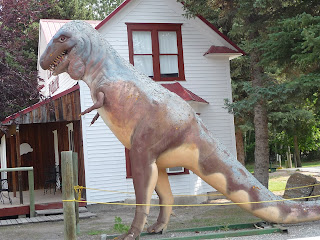Wednesday July 31
We’re in central North Dakota
now, we just went through McClusky ,
ND North Dakota . This area has many small lakes or ponds. We’re very surprised by the number of them
and that they exist at all. We crossed
Garrison Dam at the end of Lake Sakakawea, the way Sacagawea’s name is spelled
and pronounced in the Midwest . We drove
through many changes in topography as we headed east, now rolling fields as far
as the eye can see. While Montana
is known as the Big Sky state. ND could certainly share the title, especially
in the eastern part, which is very flat. Working farms quickly replaced the oil
fields and prairie as we moved east. We saw wheat, hay, corn, soybeans and fields
of beautiful blue flowers (don’t know what they are). Each town has a grain elevator, the old ones
made of wood, the new ones metal, and there are many new ones. I think ethanol production has stimulated
corn production. Many towns are celebrating their centennial, which reminds us
how recently the west was developed. We stopped for coffee at a gas station and
chatted with the attendant who had travelled east several times. He contributed to our decision to travel along
the northern shore of Lake Superior into Canada , which he said was a
beautiful area. Yesterday we met a
couple from Minnesota at Roosevelt Park Hillsboro ,
ND , just a short distance from the Minnesota border. By the way, we just learned on the news that
it is now legal to carry a gun in church in ND.
We were entertained by the sign for the Bang Church
Lewis and Clark Campground, a county campground in Hazen, ND
Almost like the Overseas Highway in the Keys
Mom must be driving again!
Crops waving in the ever-present wind. It's blowing us east
Grain (corn?) elevators near Finley, ND
Centennial celebration
Big sky, little horizon
?
Downtown Portland, ND


























































